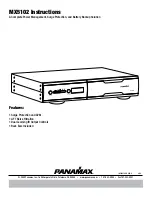
Section 2: Installation and Setup
User’s Manual 2-5
.
To fill a screen with an image, the aspect ratio of the screen should be equal to the
aspect ratio of the image (expressed as the ratio of its width to its height). Standard
video from a VCR has a 4:3 or 1.33:1 aspect ratio. For example, to display a VCR
output with a 4:3 aspect ratio onto a 10-foot (3m) high screen, the width of the screen
must be at least 13.3feet (4m).
The high brightness of this projector is well suited for locations where ambient
lighting might be considered less than ideal for projection. A typical room with ceiling
lights and windows rarely requires special attention. Contrast ratio in your images will
be noticeably reduced only if light directly strikes the screen, such as when a shaft of
light from a window or floodlight falls on the image. Images may then appear washed
out and less vibrant.
In general, avoid or eliminate light sources directed at the screen.
Other considerations and tips that can help improve your installation:
•
Keep the ambient temperature constant and below 35°C (95°F). Keep the
projector away from heating and/or air conditioning vents. Changes in
temperature may cause drifts in the projector circuitry, which may affect
performance.
•
Keep the projector away from devices, which radiate electromagnetic energy
such as motors and transformers. Common sources of these include slide
projectors, speakers, power amplifiers, elevators, etc.
Choose the best screen size for the application. Since more magnification reduces
brightness, use a screen size appropriate for the venue but not larger than required.
Installing a large screen in a small room is similar to watching television at a close
range; too large a screen can overpower a room and interfere with the overall effect.
A good rule of thumb is to be no closer than 1.5 times the width of the screen.
Throw distance
Throw distance is the distance measured from your projector’s front feet to the screen.
This is an important calculation in any projector installation as it determines whether
or not you have enough room to install your projector with a desired screen size and if
your image will be of the right size for your screen.
You can quickly estimate the throw distance by taking the horizontal width of the
screen and multiplying it by the lens throw ratio. The result of this calculation tells
you roughly how far back the projector should be positioned from the screen in order
to project a focused image large enough to fill the screen. For example, using a 0.73:1
lens, throw distance would roughly be 0.73 x screen width.
IMPORTANT:
Once you determine the type of lens and screen size you’re going to
use, calculate the precise throw distance using the formula or graphs located in
Appendix D
.
Due to lens manufacturing tolerances for lens focal length, actual
throw distance can vary
±
5% between lenses described as having the same throw
ratio.
Ambient
Lighting
'
Other
Considerations
'
Projector Position and
'
Mounting
Summary of Contents for DS+5K
Page 2: ...Downloaded From projector manual com Christie Manuals...
Page 6: ...Downloaded From projector manual com Christie Manuals...
Page 98: ...Downloaded From projector manual com Christie Manuals...
Page 110: ...Downloaded From projector manual com Christie Manuals...
Page 114: ...Downloaded From projector manual com Christie Manuals...
Page 128: ...Downloaded From projector manual com Christie Manuals...
Page 130: ...Downloaded From projector manual com Christie Manuals...
Page 148: ...Downloaded From projector manual com Christie Manuals...












































